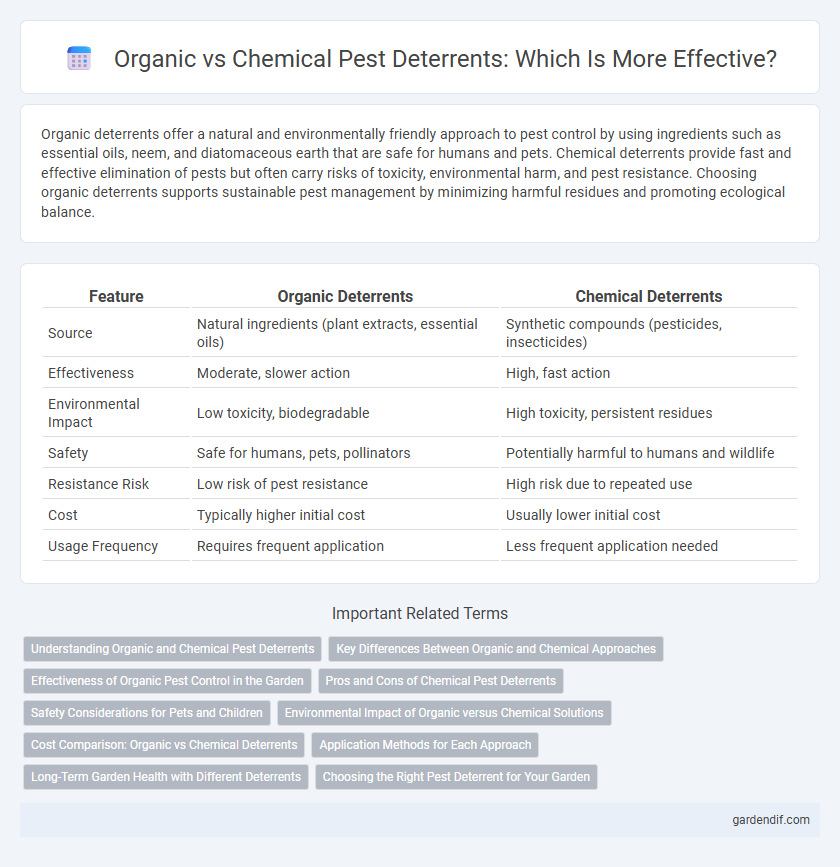
Organic deterrents vs chemical deterrents Illustration
Organic deterrents offer a natural and environmentally friendly approach to pest control by using ingredients such as essential oils, neem, and diatomaceous earth that are safe for humans and pets. Chemical deterrents provide fast and effective elimination of pests but often carry risks of toxicity, environmental harm, and pest resistance. Choosing organic deterrents supports sustainable pest management by minimizing harmful residues and promoting ecological balance.
Table of Comparison
| Feature | Organic Deterrents | Chemical Deterrents |
|---|---|---|
| Source | Natural ingredients (plant extracts, essential oils) | Synthetic compounds (pesticides, insecticides) |
| Effectiveness | Moderate, slower action | High, fast action |
| Environmental Impact | Low toxicity, biodegradable | High toxicity, persistent residues |
| Safety | Safe for humans, pets, pollinators | Potentially harmful to humans and wildlife |
| Resistance Risk | Low risk of pest resistance | High risk due to repeated use |
| Cost | Typically higher initial cost | Usually lower initial cost |
| Usage Frequency | Requires frequent application | Less frequent application needed |
Understanding Organic and Chemical Pest Deterrents
Organic pest deterrents utilize natural substances like neem oil, diatomaceous earth, and essential oils to effectively repel insects while minimizing environmental harm and promoting biodiversity. Chemical deterrents often involve synthetic pesticides such as organophosphates and pyrethroids, offering rapid pest control but posing risks of toxicity, resistance development, and pollution. Understanding the mechanisms, benefits, and drawbacks of both organic and chemical deterrents is crucial for integrated pest management strategies that balance efficacy with environmental sustainability.
Key Differences Between Organic and Chemical Approaches
Organic deterrents use natural substances such as neem oil, garlic extract, or diatomaceous earth to repel pests while minimizing environmental and health impacts. Chemical deterrents rely on synthetic compounds like pyrethroids or organophosphates, offering fast and potent pest control but with potential risks of toxicity and residue buildup. Organic methods promote sustainable pest management by preserving beneficial insects and soil health, whereas chemical approaches often disrupt ecosystems and can lead to pest resistance.
Effectiveness of Organic Pest Control in the Garden
Organic pest control methods utilize natural predators, plant-based repellents, and beneficial microorganisms to effectively reduce pest populations while preserving soil health and biodiversity. Studies show that organic deterrents are especially effective against common garden pests like aphids, caterpillars, and beetles, minimizing chemical residue and environmental impact. Consistent application and integrated pest management strategies enhance the long-term effectiveness of organic treatments in maintaining a healthy garden ecosystem.
Pros and Cons of Chemical Pest Deterrents
Chemical pest deterrents provide rapid and effective elimination of a wide range of pests due to their strong, targeted action and residual effects. However, their use poses environmental risks such as contamination of soil and water, potential harm to non-target species, and development of pest resistance over time. Users must carefully manage application and protective measures to mitigate health hazards for humans and pets.
Safety Considerations for Pets and Children
Organic pest deterrents offer a safer alternative for homes with pets and children, minimizing exposure to harmful toxins commonly found in chemical treatments. Essential oils, diatomaceous earth, and natural predators reduce pest presence without risking poisoning or allergic reactions. Chemical deterrents often contain neurotoxins and synthetic compounds that can cause severe health issues, including respiratory distress and skin irritation, especially in vulnerable household members.
Environmental Impact of Organic versus Chemical Solutions
Organic deterrents minimize environmental damage by using natural ingredients that biodegrade quickly and do not accumulate in soil or water, reducing harm to beneficial insects and wildlife. Chemical deterrents often contain persistent synthetic compounds that contaminate ecosystems, disrupt pollinator populations, and contribute to soil and water pollution. Choosing organic pest control supports sustainable agriculture and biodiversity by preventing toxic buildup and promoting ecological balance.
Cost Comparison: Organic vs Chemical Deterrents
Organic deterrents often have higher upfront costs due to natural ingredient sourcing but offer cost savings over time through environmental sustainability and reduced health risks. Chemical deterrents typically provide cheaper immediate solutions but can incur hidden expenses like soil degradation, pest resistance, and health-related costs. Long-term cost efficiency favors organic options as they promote ecological balance and minimize negative externalities.
Application Methods for Each Approach
Organic deterrents typically involve application methods such as spraying botanical extracts, applying diatomaceous earth directly to plants, or introducing beneficial insects for biological control, which prioritize environmental safety and minimal toxicity. Chemical deterrents often require precise dosage measurement and targeted spraying with synthetic pesticides to maximize efficacy and reduce non-target exposure. Both approaches demand careful timing and monitoring to ensure optimal pest management while balancing ecological impact.
Long-Term Garden Health with Different Deterrents
Organic deterrents promote long-term garden health by enhancing soil fertility and supporting beneficial insect populations, creating a balanced ecosystem that naturally controls pests. Chemical deterrents often provide immediate pest elimination but can disrupt soil microbial life, lead to chemical resistance, and harm non-target organisms, causing long-term ecological damage. Choosing organic methods ensures sustainable pest management that maintains soil structure and biodiversity over time.
Choosing the Right Pest Deterrent for Your Garden
Organic deterrents use natural ingredients like neem oil, garlic, and diatomaceous earth to safely repel pests while preserving beneficial insects and soil health. Chemical deterrents provide fast-acting, targeted pest control with synthetic compounds but may harm the environment and beneficial organisms, requiring careful application. Selecting the right pest deterrent depends on garden size, pest type, and environmental impact preferences to maintain a healthy, balanced ecosystem.
Organic deterrents vs chemical deterrents Infographic

 gardendif.com
gardendif.com